الگوی تاریخ معرفت و معاد معنا در اندیشه «شهابالدين یحیی سهروردی»
محورهای موضوعی : پژوهشهای ادبیات کلاسیک ایرانزهرا ماحوزی 1 , حسینعلی قبادی 2 , احمد پاکتچی 3 , مریم حسینی 4
1 - دانشگاه تربیت مدرس
2 - دانشگاه تربیت مدرس
3 - دانشگاه امام صادق
4 - دانشگاه الزهرا
کلید واژه: سهروردی حکمت اشراق تاریخ معرفت الگوی تاریخی حکیم الهی,
چکیده مقاله :
سهروردی در حکمت اشراق، الگویی از تاریخ معرفت را پی میگیرد که پیش از او در متون صوفیه صورت بندی شده است. این نقشه تاریخی که مبتنی بر حدیثی منسوب به پیامبر اسلام(ص) است، آینده معرفت باطنی اسلام را پس از پیامبر(ص) پیشگویی میکند و برای سرنوشت معرفت الهی در زمین، سه مرحله تعیین میکند: دوران علم حضوری، دوران امانت معنا در کلمه و دوران تبدیل استعاره به رمز. سهروردی به این نقشه تاریخی بازمیگردد و با تعریفی که از حکیم الهی و نقش وی در تأویل رموز عارفان عرضه میکند، تکملهای را برای تاریخ معرفت رقم میزند. مرحله چهارمی که سهروردی بر این الگوی تاریخی میافزاید، مرحله معاد معنا به حقیقت آن است و تعریف آن تنها با رجوع به کلیّت نظام حکمی سهروردی ممکن میشود. مقاله حاضر میکوشد تا این الگوی تاریخی را از متون صوفیه استخراج کند سپس به تبیین نقش سهروردی در تکمیل آن بپردازد.
The history of knowledge that is considered by Sohrewardi in Hikmat-Al-Ishraq follows a pattern that has been formulated before him in the Sufi texts. This historical pattern which is based on a hadith attributed to the Prophet (peace be upon him) foretells the future of esoteric knowledge of Islam after the Prophet. As to the fate of divine knowledge on earth, this pattern defines three stages: the era of knowledge by presence, the era of assenting meaning to the word, and the period in which metaphor is converted to symbol. Sohrewardi refers to this historical pattern and completes it by presenting a certain definition of the Divine Hakim and his role in interpreting the mysteries of the mystics. By this action, he makes a commentary on the history of knowledge. The fourth stage that Sohrewardi adds to this historical pattern is the resurrection stage of meaning to its truth, and it can be defined only by reference to the totality of Sohrewardi's intellectual system. The present article attempts to extract this historical pattern from the Sufi texts and then explains Sohrewardi's role in completing it.
